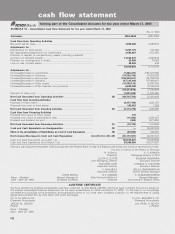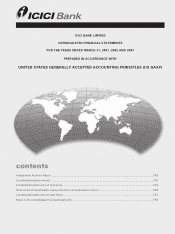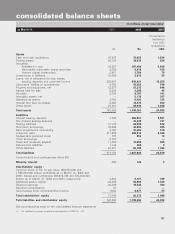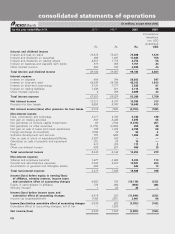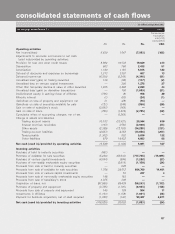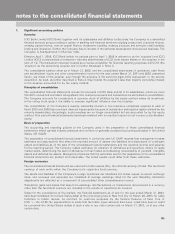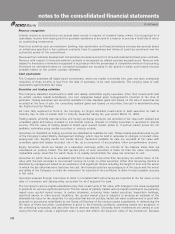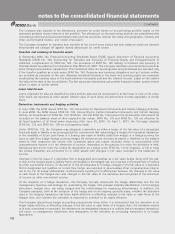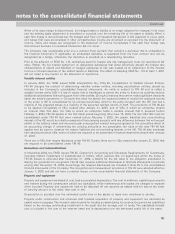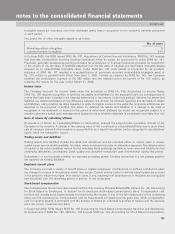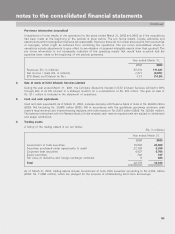ICICI Bank 2003 Annual Report Download - page 124
Download and view the complete annual report
Please find page 124 of the 2003 ICICI Bank annual report below. You can navigate through the pages in the report by either clicking on the pages listed below, or by using the keyword search tool below to find specific information within the annual report.
F60
Continued
notes to the consolidated financial statements
Revenue recognition
Interest income is accounted on an accrual basis except in respect of impaired loans, where it is recognized on a
cash basis. Income from leasing and hire purchase operations is accrued in a manner to provide a fixed rate of return
on outstanding investments.
Fees from activities such as investment banking, loan syndication and financial advisory services are accrued based
on milestones specified in the customer contracts. Fees for guarantees and letters of credit are amortised over the
contracted period of the commitment.
Revenues from software development and services comprise income from time-and-material and fixed-price contracts.
Revenue with respect to time-and-material contracts is recognized as related services are performed. Revenue with
respect to fixed-price contracts is recognized in accordance with the percentage of completion method of accounting.
Provisions for estimated losses on contracts-in-progress are recorded in the period in which such losses become
probable based on the current contract estimates.
Cash equivalents
The Company considers all highly liquid investments, which are readily convertible into cash and have contractual
maturities of three months or less from the date of purchase, to be cash equivalents. The carrying value of cash
equivalents approximates fair value.
Securities and trading activities
The Company classifies investments in debt and readily marketable equity securities, other than investments held
by certain venture capital subsidiaries, into two categories based upon management’s intention at the time of
purchase: trading securities and securities available for sale. Realized gains and losses on the sale of securities are
recorded at the time of sale. For computing realized gains and losses on securities, the cost is ascertained using
the First-In-First-Out Method.
As more fully explained in Note 6, the Company no longer classifies investments in debt securities as held to
maturity, due to sale of certain held to maturity securities during the year ended March 31, 2002.
Trading assets, primarily debt securities and foreign exchange products, are recorded at fair value with realized and
unrealized gains and losses included in non-interest income. Interest on trading securities is recorded in interest
income. The fair value of trading assets is based upon quoted market prices or, if quoted market prices are not
available, estimates using similar securities or pricing models.
Securities not classified as trading securities are classified as available for sale. These include securities used as part
of the Company’s asset liability management strategy, which may be sold in response to changes in interest rates,
prepayment risk, liquidity needs and similar factors. Securities available for sale are recorded at fair value with
unrealized gains and losses recorded, net of tax, as a component of accumulated other comprehensive income.
Equity securities, which are traded on a securities exchange within six months of the balance sheet date are
considered as publicly traded. The last quoted price of such securities is taken as their fair value. Non-readily
marketable equity securities for which there is no readily determinable fair value are recorded at cost.
Securities on which there is an unrealized loss that is deemed to be other than temporary are written down to fair
value with the loss recorded in non-interest income as a loss on other securities. Other than temporary decline is
identified by management based on an evaluation of all significant factors including the length of time and the extent
to which the fair value has been less than the cost, the financial condition and prospects of the issuer and the extent
and ability of the Company to retain the investment for a period of time sufficient to allow for any probable recovery
in fair value.
Securities acquired through conversion of loans in a troubled debt restructuring are recorded at the fair value on the
date of conversion and subsequently accounted for as if acquired for cash.
The Company’s venture capital subsidiaries carry their investments at fair value, with changes in fair value recognized
in gain/loss on venture capital investments. The fair values of publicly traded venture capital investments are generally
based upon quoted market prices. In certain situations, including thinly traded securities, large-block holdings,
restricted shares or other special situations, the quoted market price is adjusted to produce an estimate of the
attainable fair value for the securities. For securities that are not publicly traded, fair value is determined in good faith
pursuant to procedures established by the Board of Directors of the venture capital subsidiaries. In determining the
fair value of these securities, consideration is given to the financial conditions, operating results and prospects of
the underlying companies, and any other factors deemed relevant. Generally, these investments are carried at cost
during the first year, unless a significant event occurs that effects the long-term value of the investment. Because


